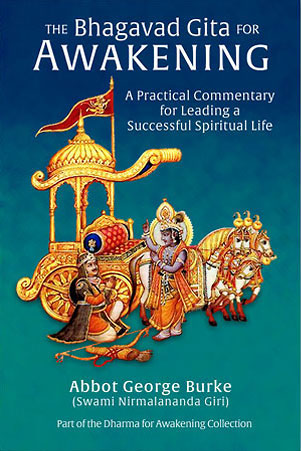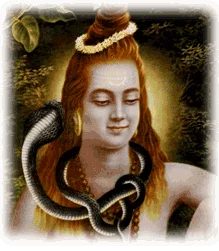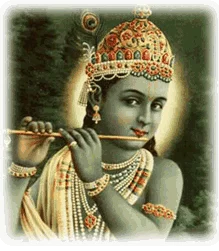
The eleven major Upanishads present the supreme philosophy, the supreme ideal. The Gita, being a virtual digest of the Upanishads, does the same, but it goes into the practical application of those principles, and even further into a description of the effects of that application. The Gita describes perfectly the state of the enlightened human being–at least as perfectly as human speech is able to delineate. It is these descriptions which we should study carefully, leaving aside the absurd questions that contemporary mind-gamers have come up with such as: Does a jnani have a subconscious mind–and if not, does the jnani dream?
In the Gita we find the psychology of the jnani completely expounded, and it is something that cannot possibly be observed by any other than the jnani himself. As Yogananda wrote: “He who knows–he knows. None else knows.” Our job is to become jnanis, not to figure out if someone else is a jnani–though that is a lot easier on the ego.
Krishna is now going to give us a picture of a sage in action, and yet beyond action.
Whose undertakings are devoid of plan and desire for results, whose actions are consumed in the fire of knowledge–him the wise call wise (4:19).
Devoid of plan and desire for results. To act rightly–to do the right thing in the right way at the right time in the right place–and nothing more: that is the way of the Gita. Therefore, to keep the fruit, the effect, of an act in mind as our purpose, is to deflect ourselves from the right motivation and to entangle ourselves in the net of egotism and the snare of binding deeds. Two forces impel us into this trap: desire (kama) and motive (sankalpa).
Kama is desire, passion, or lust. The first meaning, that of desire, is uppermost in this part of the Gita. Though people can pursue action with a blinding and binding passion, it is best for us to think mostly of simple desire, since the palest shade of desire can mar our action. Also, desire can be incredibly subtle and undetectable to any but the keenest intelligence. Passion and lust, on the other hand, are extremely obvious and impossible to disguise–though many in their grip pretend that they are being dedicated, noble, and fervent in a righteous cause. Human beings can talk themselves into anything. But sensible people can see the fiend beneath the fever. Desire, though, is capable of disguising itself or hiding itself completely from all but the most perceptive. This is why tapasya, not intellectual analysis, is the only sure way of uprooting this subtle enemy.
Sankalpa is wish, desire, volition, resolution, will, determination, and intention. Yes; all that. Any kind of intentions–including subconscious ones–mar action. Even the slightest wish or hope in relation to the result of an action turns it into a bond. No wonder Krishna says later on: “Truly this maya of mine made of the gunas is difficult to go beyond” (7:14).
But when a person becomes absolutely free of kama and sankalpa, his action slips away like a loosened bond. Even more: the binding power of the act is broken so it cannot arise in the future to be a hindrance. Someone in this state then ceases to create any more karma.
Whose actions are consumed in the fire of knowledge. There is a lot of talk about eliminating karma, as though it were something to throw away or wash down the drain. Not so. Karma must be burned in the fire of knowledge–jnanagni. As genuine camphor burns and leaves no residue whatsoever, but just vanishes, so it is with karma burned in the fire of knowledge. It is absurd to say that a liberated person still has to undergo his prarabdha karma–karma that has begun to manifest and bear fruit. This mythology is a rationalization put forth by whose who claim their guru is liberated while still very obviously bound by karma. A liberated person may decide to remain in this world, though having no karma to fulfill. God does not need karma to enable him to project the creation, and a liberated being does not need any karma to remain here on earth. If he cannot do so, then he is not a Master, and not liberated.
(However, some masters can selectively burn their karma, and retain miniscule karmic “threads” which they can use to more easily come into future incarnations. Nevertheless, they are not bound or obligated by prarabdha karma. They are masters even of karma.)
Complete in the Self
Having abandoned attachment for action’s fruit, always content, not dependent on anything even when acting, he truly does nothing at all (4:20).
Nevertheless, he does act. That is, he turns his face from the fruits of action, not even looking at them, lest like Eve (Genesis 3:6), he be drawn again to desire them and fall away from the state he has so laboriously attained.
The enlightened man is literally Self-sufficient. “When he leaves behind all the desires of the mind, contented in the Self by the Self, then he is said to be steady in wisdom” (2:55). “He who is content only in the Self, who is satisfied in the Self, who is pleased only in the Self: for him there is no need to act” (3:17).
Having gone beyond the realm of action, he truly “perceives inaction in action and action in inaction” (4:18).
Complete control
Acting with the body alone, without wish, with thought and lower self restrained, abandoning all acquisitiveness, though acting he incurs no fault [guilt or evil] (4:21).
Here again we see that Krishna is not advocating some kind of self-effacing passivity. Rather he is showing us heroic endeavor. Certainly the wise man does not desire or will the fruits of action, but to ensure he never again falls into the old pattern of delusion he exercises absolute control over body and mind. Enlightenment is not an avoidance of body and mind and their influences, it is mastery in the fullest sense.
For ages in India a crippling passivity and indifference has been cultivated due to the degenerative influence, especially, of ignorant sannyasis who have held a completely wrong idea about their own way of life–a wrong idea which they hold up to non-monastics as an ideal to also follow. Shamefulness has become a virtue, cowardice touted as courage, and ineffectiveness as skill in action. Yet the Gita has all the time stood in virile contrast to this effete cowardice and cultivated incompetence.
Swami Vivekananda devoted his life to arousing his countrymen to abandon the horrible morass into which they were complacently sinking. Still the illusion prevails. No wonder many in India feel that they need to shake off religious influence to become self-respecting and worthy human beings. This is a sad misconception, for as Vivekananda remarked upon returning to India after his first trip abroad, India’s problem is not its religion, but the fact that it has not been rightly practiced. The deadening effect of the false “brahmarishis” has blinded not only India but the world to the way of the “rajarishis” advocated by Krishna.
Controlling body and mind the wise realizes that he is the Self. Nothing is his own, for the Self transcends all things. Thus he acts and incurs no karma.
Symptoms of control
Now comes a verse that the foolish have used to bolster their advocacy of passivity and worthlessness–of spiritual and mental novocain.
Content with what comes unbidden, beyond the pairs of opposites and free from envy, the same in success or failure, even though acting, he is not bound (4:22).
I will not waste your time pointing out what this does not mean. Others will do that gladly–and solely.
Content with what comes unbidden. That is, he is content with whatever occurs or comes to him as a result of his prarabdha karma, the karma that is presently manifesting as this particular life. This karma is spontaneous, occurring automatically.
The wise man accepts that which comes to him because it is his own action coming to fruition. He does not desire or anticipate the fruits of his present actions, but he thoroughly accepts the advent of the results of his past actions that have created this life and determined its quality and events. Does this mean he is merely passive, with a “What can I do?” attitude? Not at all. He understands that his prarabdha karma is not some kind of reactive payback for past deeds, but that its purpose is his learning, his evolution. Karma is a real lesson in living. We accept it, but we also study it and learn what it is saying to us. Otherwise we will fail the lesson and have to keep taking it over and over until we do learn. The adage that history repeats itself is true because we do not learn from it and apply it to our personal life as well.
The intelligent individual understands that all our life is a learning session, that pleasant karma is not to just be enjoyed or unpleasant karma endured or avoided. Rather, it is to be learned from. We must get involved with our karma and use it for our betterment. Karma is not fate; it is opportunity. Only when we live accordingly can we be considered worthy of human birth. Meeting karma head-on is the way to master it and profit from it. This requires our full acceptance of it, but with the right understanding of it.
Beyond the dualities [pairs of opposites]. Whatever comes or goes is a matter of his own previous choices–so the yogi views all phenomena, not preferring one or the other. This is because he sees value in both the pleasant and the unpleasant, seeing neither of them as undesirable. They are part of his life-script which he must read and comprehend. Everything is for his betterment. Consequently he looks to the wisdom to be gained and not the superficial external experience.
Free from envy. He is free from envy or greed because whatever comes to him is a matter of his own doing. Who will he envy? Can he be jealous of someone who had the good sense to order the right things from the storehouse of life? He could have the same if he had been wiser, and he can get anything he wants in the future. He need only use life more competently. No wonder Buddha kept emphasizing the need for skillful action. It is pointless to attempt transcending this life until we have lived it worthily. Many yogis come to naught because they think yoga is a means of escape from the lessons of life. Until we learn, we do not graduate to a higher grade. “Those who are too good for this world are adorning some other,” as Swami Sri Yukteswar often pointed out. Until then, here we will stay.
The same in success or failure. This is not because he shrugs and says: “Oh, well, that is my karma,” and bumbles on without a sense of responsibility. Yes, indeed, it is his karma, whether of the present or the past, and it reveals how well or how poorly he acted in the past. He may not desire certain results of his actions, but he definitely gets their message. Success and failure are only symptoms of wisdom or folly. He astutely evaluates the root of his consciousness, seeing his actions as the branches and leaves of that root. His work is with the root; the rest will follow suit when the right quality has been attained. Effects have value only as indicators of the nature of the cause. He knows this, and is intent only on the rectification of the cause: his state of awareness.
Even though acting, he is not bound. For he does not look at the results of action, but is the witness of the acts. The Self is never touched or bound by action. Centering his consciousness in the truth of his being through diligent practice of meditation, he is freed from karmic effects.
Once again we see the value of Vyasa presenting the teachings of the Gita in the context of the Mahabharata War. Krishna is urging Arjuna to engage in battle, assuring him that if he does so rightly he will incur no negative karma. Instead, he will be released from the karma that brought him to Kurukshetra, the Field of Dharma. If this is true of warfare, how can we hesitate to engage optimistically in our comparatively easy and insignificant karmic struggles?
The result
The karma of one who is free from attachment, whose thought is established in knowledge, undertaking action for sacrifice, is wholly dissolved (4:23).
It is a matter of both knowledge and attitude.
Brahman is the offering, Brahman is the oblation poured out by Brahman into the fire of Brahman. Brahman is to be attained by him who always sees Brahman in action (4:24).
Knowers of Brahman know their entire life as sacrifice (yajna). Here, particularly, the fire sacrifice or havan is the symbol of the Brahmajnani’s unbroken awareness of Brahman.
Brahman is the offering. All action whatsoever is a manifestation of the power of God. Everything that is done is God. This is because the entire realm of relative existence is not a thing at all; at no time does it have a material, objective existence. Rather, it is the thought of God, the divine Thinker, the dream of God, the divine Dreamer. It is a motionless movement within the Consciousness that is God. Thus everything is God in the most literal and most absolute sense. The “offering” of evolution within relative existence is Brahman itself. There is nothing else.
Brahman is the oblation. Everything that we deal with in our evolutionary journey, whatever we employ to further the expansion of our consciousness, whatever we offer to God in our attempt to ascend to the Absolute–all that is Brahman alone.
Poured out by Brahman. All the waves of the ocean are the ocean. Every sentient being, every spark of individualized consciousness, is Brahman. Those who seek Brahman are Brahman. That is, Brahman is their essential, inseparable nature. None but Brahman worships and seeks Brahman. None but Brahman finds Brahman.
Into the fire of Brahman. Again, the entire range of dynamic, seemingly ever-changing field of evolutionary life is Brahman alone. It is Brahman that is the transmuting fire of the cosmos. Brahman is itself the Eternal Phoenix that is perpetually consumed by itself and produced from itself in never-ending cycles that are themselves “the fire of Brahman.”
Brahman is to be attained by him who always sees Brahman in action. “The yogi whose mind is truly tranquil, with emotions [passions] calmed, free of evil, having become one with Brahman, attains the supreme happiness. Thus constantly engaging himself in the practice of yoga, that yogi, freed from evil, easily contacting [touching] Brahman, attains boundless happiness. He who is steadfast in yoga [yoga-yukta] at all times sees the Self present in all beings and all beings present in the Self. He who sees me everywhere, and sees all things in me–I am not lost to him, and he is not lost to me. He, established in unity, worships me dwelling in all things; whatever be his mode of life, that yogi ever abides in me” (6:27-31).
Even if at the time it is mostly intellectual rather than purely intuitive, we must strive to “see through” all action to Brahman, the Ground of All Being.
Read the next article in the Bhagavad Gita for Awakening: Sacrificial Offerings







